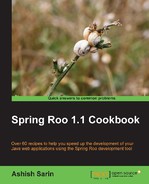As of Spring Roo 1.1.3, both entity and persistence setup commands support the persistenceUnit argument which lets you create enterprise applications which interact with multiple databases. In this recipe we'll create two persistent units:
flight: theflightpersistence unit consists of a single entity,Flight. It uses Hibernate as a JPA provider and maps to a MySQL database named "myFlightDB".payment: thepaymentpersistence unit consists of a single entity,Payment. It uses Hibernate as the JPA provider and maps to a MySQL database named "myPaymentDB".
Exit the Roo shell and delete the contents of the C:
oo-cookbookch02-recipes directory.
Start the Roo shell from the C:
oo-cookbookch02-recipes directory.
The following steps will demonstrate how to create an application that interacts with multiple databases:
- Create the
flight-appRoo project:..roo> project --topLevelPackage sample.roo.flightapp --java 6 --projectName flight-app - Set up the
flightpersistence unit:..roo> persistence setup --provider HIBERNATE --database MYSQL --databaseName myFlightDB --persistenceUnit flight - Create
Flightentity, which is associated with theflightpersistence unit:..roo> entity --class ~.domain.Flight --table FLIGHT_TBL --persistenceUnit flight - Add some fields to the
Flightentity:~.domain.Flight roo> field string --fieldName origin --column FLT_ORIGIN --notNull ~.domain.Flight roo> field string --fieldName destination --column FLT_ DESTINATION --notNull
- Create an integration test for the
Flightentity:~.domain.Flight roo> test integration - Set up the
paymentpersistence unit:.. roo> persistence setup --provider HIBERNATE --database MYSQL --databaseName myPaymentDB --persistenceUnit payment - Create the
Paymententity, which is associated with thepaymentpersistence unit:.. roo> entity --class ~.domain.Payment --table PAYMENT_TBL --persistenceUnit payment - Add fields to the
Paymententity:~.domain.Payment roo> field string --fieldName paymentType --column PYMT_TYPE --notNull - Create an integration test for the
Paymententity:~.domain.Payment roo> test integration - Execute the
performeclipsecommand to import theflight-appproject into Eclipse IDE:~.domain.Payment roo> perform eclipse - Execute the integration tests:
.. roo> perform tests
Executing the integration tests at this time will result in failure. We'll shortly see what we need to do to get the tests working when using multiple databases.
The concept of a persistence unit is not only useful when the enterprise application interacts with multiple databases but also when you want to logically group entities in your application. Using different persistence units can also be useful if you want to use different persistence providers for different logical groups of entities.
When setting up a persistence provider using the persistence setup command you can specify the persistence unit name by specifying the persistenceUnit argument. Also, when creating entities using the entity command you can use the persistenceUnit argument to specify the persistence unit to which the entity belongs. Spring Roo makes use of the persistenceUnit argument of the persistence setup command to define a different persistence unit in the /META-INF/persistence.xml file. The following listing shows the persistence.xml file of the flight-app project after the execution of the persistence setup commands:
<persistence ..> <persistence-unit name="flight" transaction-type="RESOURCE_LOCAL"> <provider> org.hibernate.ejb.HibernatePersistence </provider> .. </persistence-unit> <persistence-unit name="payment" transaction-type="RESOURCE_LOCAL"> <provider> org.hibernate.ejb.HibernatePersistence </provider> .. </persistence-unit> </persistence>
In the code, the name attribute of the <persistence-unit> element reflects the persistenceUnit argument value that you specified in the persistence setup command. As we have specified Hibernate as the JPA provider for both flight and payment persistent units, the <provider> element contains org.hibernate.ejb.HibernatePersistence as the JPA provider. If you want to use different JPA providers for your persistence unit, then specify it using the provider argument of the persistence setup command.
As we are using different persistence units, the entities created using the entity command use the persistenceUnit attribute to identify the persistence unit with which the entity is associated. The following code listing shows that the persistenceUnit argument value is used in the @RooEntity annotation of the Flight class:
@RooJavaBean
@RooToString
@RooEntity(persistenceUnit = "flight", table = "FLIGHT_TBL")
public class Flight {..}In the code, the value of the persistenceUnit attribute of @RooEntity is flight, which affects the way Roo generates the corresponding *_Roo_Entity.aj AspectJ ITD file. The following code listing shows the affect of persistenceUnit attribute of @RooEntity annotation on the Flight_Roo_Entity.aj ITD file:
privileged aspect Flight_Roo_Entity {
@PersistenceContext(unitName = "flight")
transient EntityManager Flight.entityManager;
...
@Transactional("flight")
public void Flight.persist() {..}
@Transactional("flight")
public void Flight.remove() {..}
...
}In the code, the @PersistenceContext annotation makes use of the unitName attribute to specify the persistence unit with which the EntityManager persistence context is associated with. Also, notice that the @Transactional annotation now makes use of the flight qualifier to specify the transaction manager required for managing transactions.
As of Spring Roo 1.1.3, you'll have to ensure that the transaction manager, entity manager factory, and data source bean definitions for each persistence unit are configured in the /META-INF/spring/applicationContext.xml file, as shown here:
<bean class="org.apache.commons.dbcp.BasicDataSource"
destroy-method="close" id="flightDataSource">
....
</bean>
<bean class="org.apache.commons.dbcp.BasicDataSource"
destroy-method="close" id="paymentDataSource">
....
</bean>
<bean
class="org.springframework.orm.jpa.JpaTransactionManager"
id="flightTransactionManager">
<qualifier value="flight"/>
<property name="entityManagerFactory"
ref="flightEntityManagerFactory"/>
</bean>
<bean
class="org.springframework.orm.jpa.JpaTransactionManager"
id="paymentTransactionManager">
<qualifier value="payment"/>
<property name="entityManagerFactory"
ref="paymentEntityManagerFactory"/>
</bean>
<tx:annotation-driven mode="aspectj"
transaction-manager="flightTransactionManager"/>
<tx:annotation-driven mode="aspectj"
transaction-manager="paymentTransactionManager"/>
<bean
class="org.springframework.orm.jpa.
LocalContainerEntityManagerFactoryBean"
id="flightEntityManagerFactory">
<property name="persistenceUnitName" value="flight"/>
<property name="dataSource" ref="dataSource"/>
</bean>
<bean class="org.springframework.orm.jpa.
LocalContainerEntityManagerFactoryBean"
id="paymentEntityManagerFactory">
<property name="persistenceUnitName" value="payment"/>
<property name="dataSource" ref="dataSource"/>
</bean>The code shows that different transaction managers, entity manager factories, and data source beans are configured for each persistence unit. The transaction manager bean definitions make use of the <qualifier> element, so that @Transactional annotations can refer to the target transaction manager using a qualifier. Also, the LocalContainerEntityManagerFactoryBean is passed the persistence unit name with which it is associated, using the persistenceUnitName property.
To ensure that integration tests work, you'll also need to specify the transaction manager to use for the test methods annotated with the @Transactional annotation. To achieve this, all you need to do is specify the @Transactional annotation in your test class, as shown here for PaymentIntegrationTest class:
@RooIntegrationTest(entity = Payment.class)
@Transactional("payment")
public class PaymentIntegrationTest {
@Test
public void testMarkerMethod() {
}
}